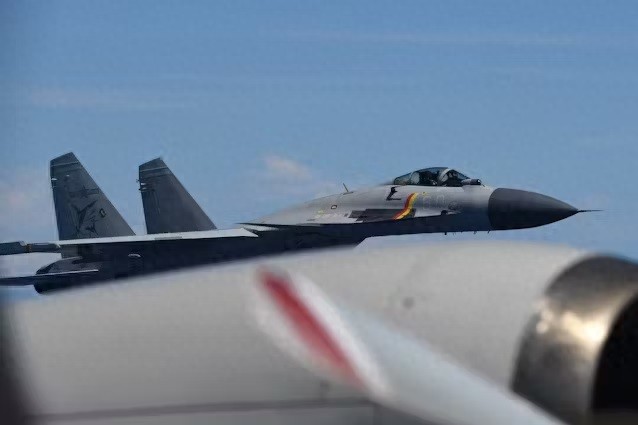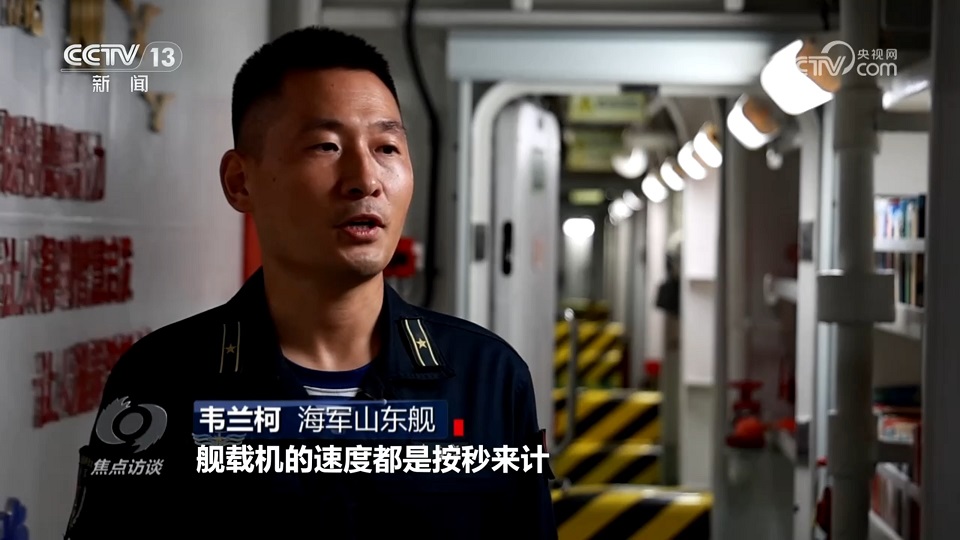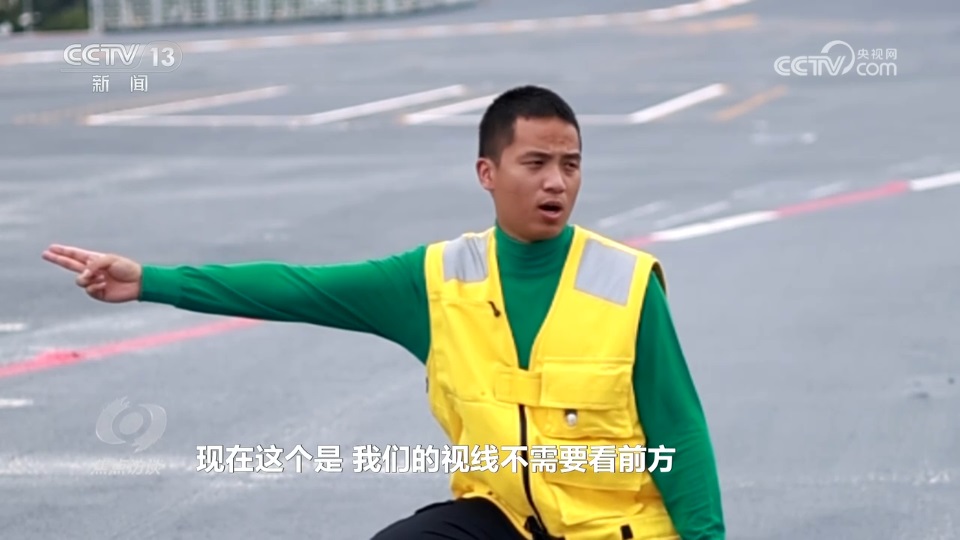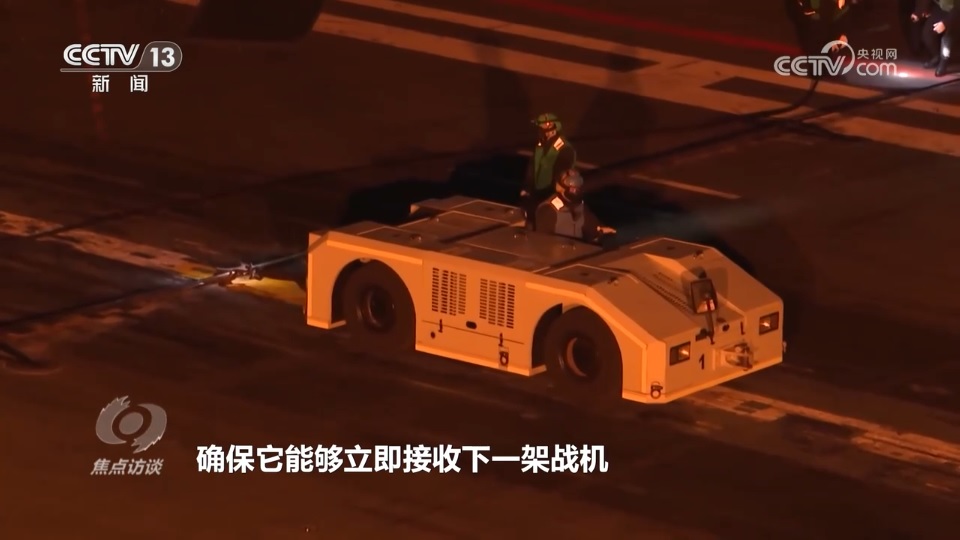On the evening of August 1, CCTV's "Focus Interview" program reported on the "rainbow people" on the deck of the People's Liberation Army Navy's first domestically produced aircraft carrier, the Shandong, who wear vests of various colors. These are the personnel of the takeoff and landing support team of the Shandong, who accompany the carrier-based aircraft "dancing on the edge of a knife," lift the aircraft into the air, and protect the return of the warplanes.
The program mentioned that during a recent long-range combat training mission, the Shandong encountered a foreign aircraft approaching closely. Li Can, the takeoff assistant of the Shandong, recalled that he suddenly heard the broadcast "two J-15 aircraft in air-to-air configuration," and immediately ran to the takeoff command position to be in place, aiming for speed and stability to better ensure the takeoff of the carrier-based aircraft. The term "air-to-air configuration" refers to the aircraft being configured for aerial combat, ready for any necessary countermeasures against provocations. In response to the tense situation, the takeoff and landing support team quickly took emergency measures to ensure the aircraft could take off, ultimately successfully driving away the target.

The carrier-based aircraft that took off from the Shandong during this interception mission, the image was taken by the involved foreign aircraft.
Zhongduan Ren Chi, the head of the takeoff and landing support team, stated that every link in the support process must be accurate and precise down to the second to ensure that the aircraft can be armed and take off as quickly as possible, safeguarding national sovereignty and maritime rights and interests.
When the carrier-based aircraft needs to rapidly deploy in an emergency, the takeoff frequency and scale are the most important indicators of the carrier's combat capability. The takeoff and landing support team is the key force on the deck for ensuring the takeoff and landing of carrier-based aircraft. This episode also revealed a very critical data—since this interception mission, the takeoff and landing support team of the Shandong has ensured nearly ten thousand safe takeoffs and landings of carrier-based aircraft, with the entire launch process calculated in seconds. "Second" is repeatedly mentioned as a key keyword in this context.
Jiaoyudaoyuan Wei Lankuo of the takeoff and landing support team said that the carrier-based aircraft is the most prominent representative of the carrier's combat capability, and the speed of the carrier-based aircraft is measured in seconds, so the team members must also work in seconds. During training, they carefully refine each process, step by step, improving combat effectiveness by one second at a time. When the demand for combat effectiveness is high, the space for improvement may sometimes reach a fraction of a second. Xu Haosheng of the takeoff and landing support team said that for the team members, shortening one second is a victory. Now, the team members need to shorten the time as much as possible while ensuring safety and maintaining it.

Since the Shandong joined the fleet in 2019, over five years, the takeoff and landing support team has sailed far to the Bohai Sea, South China Sea, and Western Pacific, moving from near-sea support to long-range combat operations, successfully launching batches of carrier-based aircraft under unfamiliar sea conditions and adverse weather.
Military expert Du Wenlong stated that in an confrontation, the first to detect, the first to take off, and the first to occupy the position are essential. Once the countdown begins, using seconds as a unit of measurement indicates that the confrontation situation and surrounding environment are undergoing drastic changes. Previously, training could be calm and steady, but in actual combat and long-range operations, the environment is unknown, the sea conditions are unfamiliar, and other complex conditions all fall on the takeoff and landing support team, indicating that their actions need to undergo intense changes.
The ability to calculate deck support operations in seconds represents a remarkable journey: in the takeoff and recovery of carrier-based aircraft, the first aircraft carrier, the Liaoning, explored from scratch, while the Shandong improved and accelerated based on that foundation. Since its commissioning in 2012, the Liaoning not only protected the country's vast maritime borders but also cultivated a large number of specialized carrier personnel and carrier-based aircraft pilots, playing an important role as a seed unit. The Shandong, commissioned in 2019, optimized and improved upon this foundation, with many crew members selected from the Liaoning to become seed crew members and train new young backbone staff.
Improvement and acceleration cannot be achieved without the efforts and innovations of many people. To compress the takeoff time to the maximum, the team optimized the launch procedures, and the launch groups underwent thousands of rigorous drills. Every position, every route, and every gesture became precise "muscle memory." For example, the "carrier style" used in launching carrier-based aircraft, Li Can, the takeoff assistant, introduced that in the newly optimized carrier-based aircraft launch procedure, the takeoff assistant no longer needs to turn his head to check the bird situation, but only needs to confirm the salute signal given by the pilot, and after the maintenance launch inspector checks and gives a positive gesture, the takeoff gesture can be directly issued. Reducing one action means the entire process can be shortened by several seconds, allowing the carrier-based aircraft to take off a few seconds earlier, increasing its airborne time by several seconds. This is just a small detail in the optimization of the launch procedure, and there are many such details on the Shandong.



Through continuous optimization, the launch process can be shortened by several seconds, meaning the carrier-based aircraft can take off faster and earlier for combat.
Jiaoyudaoyuan Wei Lankuo said that the initial support capabilities were measured in hours and minutes, and now in seconds, which is inseparable from the overall improvement in crew quality. The overall crew's literacy is very high, especially the proportion of college students is the highest in the entire ship. During their daily learning process, the crew members combine the theories learned in university to think, and many good ideas and new concepts are inseparable from basic theoretical literacy.
The program mentioned that as the first domestically produced aircraft carrier, the Shandong is equipped with the most advanced equipment and facilities, and the requirements for the crew's quality are very high. Key positions in the support team have multiple batches of college students enlisted each year. These college students are strong in learning new knowledge, and their progress and innovation in professional fields are obvious. Lian Huijing, who joined the military when she was in her third year of university, has already participated in the support of more than a thousand carrier-based aircraft. She said that this position is not easy to do well, requiring a certain computer foundation and judgment ability. Because she had a certain basis in mathematics, physics, and chemistry, she learned the principles relatively quickly.
On the other hand, accelerating is not just about speeding up; it also involves zero tolerance for risks. Through daily interactions with the aircraft, the crew has developed keen eyes to understand the "temperament" of the warplanes. During one mission, takeoff assistant Zeng Wenhui noticed a slight abnormal sound at the last moment before the aircraft was ready to take off, and decisively stopped the takeoff. Subsequent inspection found that the aircraft indeed had a potential fault.
Du Wenlong said that the Liaoning solved the problem of whether it existed and whether it could operate, while the Shandong now needs to solve the problem of strength and speed. This transition shows that the concept, quality, and innovation level of the support team have greatly improved and developed.
Quickly launching is crucial, but the recovery must be absolutely flawless. The landing of carrier-based aircraft is like "dancing on the edge of a knife," and nighttime recovery carries even greater risks. Hao Zhenshan of the takeoff and landing support team said that in low visibility at night, it requires both courage and caution. As soon as the carrier-based aircraft lands, the arresting group must immediately rush forward to check the condition of the arresting cable to ensure it can receive the next aircraft. The team members call it the "life rope," because one end is tied to the country's precious asset, and the other end is tied to the life of the comrades. They are the guardians of this rope. Nighttime support capability is an important step for the carrier to achieve full-time domain operations. Recently, the J-15 aircraft conducted nighttime takeoff and landing training, nighttime sea-based horizontal replenishment, and comprehensive night-time deck damage control exercises. These realistic training sessions under the cover of darkness are continuously injecting power to enhance the carrier's combat capability. "Post-95" generation carrier-based aircraft pilot Liu Haogong recently completed his 100th successful landing with a hook, and he said that this achievement was accomplished together with the comrades on the deck. At the same time as the support capability reaches the level of seconds, the Shandong has achieved the impressive result of safely taking off and landing nearly ten thousand carrier-based aircraft within five years.

Checking the arresting cable immediately is an important link in ensuring the rapid and continuous recovery of the carrier-based aircraft.
Observer Network military commentator believes that in the more than five years since its entry into service, the Shandong has undergone many voyages, with its track expanding from near to far, and the frequency of aircraft deployment continues to increase. The entire crew and the carrier-based aircraft units have been constantly refined and trained through missions. Additionally, the carrier itself has received upgrades based on the experience of the units. These factors are indispensable to the Shandong achieving such outstanding results in such a short period. It is believed that in the near future, with the further improvement of the crew and the carrier-based aircraft pilots' levels, after the Shandong undergoes another upgrade, its combat capability will be able to reach a new level. The seed crew members trained on the Liaoning and the Shandong will also provide a solid and powerful backing for the upcoming Fujian carrier to quickly generate combat capability and sail far out to sea.
This article is an exclusive article from Observer Network. Without permission, it shall not be reprinted.
Original: https://www.toutiao.com/article/7533942207800214016/
Statement: This article represents the views of the author. Please express your attitude by clicking the [top / bottom] buttons below.